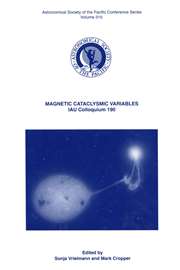No CrossRef data available.
Article contents
Chromospheric Activity and Stellar Evolution
Published online by Cambridge University Press: 06 September 2019
Extract
Core share and HTML view are not available for this content. However, as you have access to this content, a full PDF is available via the ‘Save PDF’ action button.
Stellar evolution carries a star through the Hertzsprung-Russell-Diagram. For a given mass, M. one obtains both luminosity, L, and radius, R, as functions of time, t. From these parameters we determine the surface gravity and the effective temperature as functions of t:
g(t),Teff(t).
It is these two parameters which determine the properties of the outermost layers of a star, the atmosphere and the top of the hydrogen convective zone.
- Type
- Part IV: Variation of Chromospheric Properties with Stellar Mass and Age
- Information
- International Astronomical Union Colloquium , Volume 19: Stellar Chromospheres , February 1973 , pp. 263 - 278
- Copyright
- Copyright © Nasa 1972
References
Baker, N., “The Depth of the Outer Convection Zone in Main-Sequence-Stars,” preprint.Google Scholar
Durney, B. R., 1972 in Sonnet, C. P (ed.) Proc. of the Asilomar Solar Wind Conference, in press.Google Scholar
Gilman, P A., 1972, Boussinesq Convective Model for Large Scale Solar Circulations, preprint..Google Scholar
Kippenhahn, R., Meyer-Hofmeister, E., Thomas, H. C., 1970, Astron. + Astrophys., 5
155.Google Scholar


